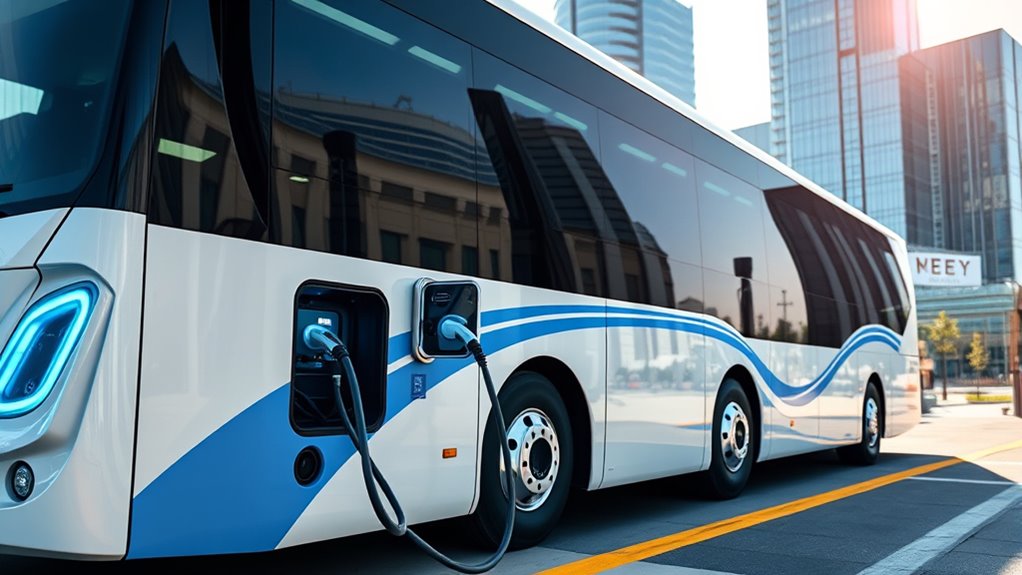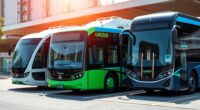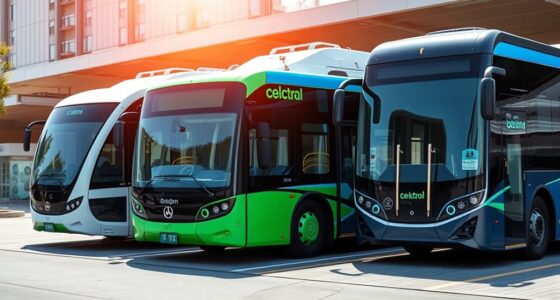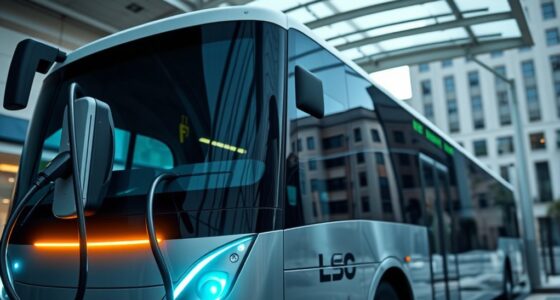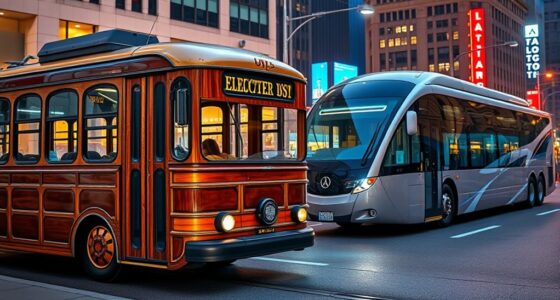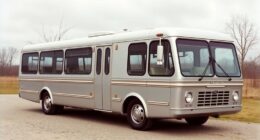Electric buses run on onboard batteries or hydrogen fuel cells that supply clean energy for travel. The batteries store electricity and can be recharged at depots or with fast chargers, while hydrogen fuel cells convert hydrogen into electricity, emitting only water vapor. These vehicles use electric motors for smooth, instant acceleration and incorporate regenerative braking to recover energy. To learn more, see how advanced power systems and safety features make electric buses efficient and eco-friendly.
Key Takeaways
- Electric buses rely on onboard batteries or hydrogen fuel cells to generate and store electrical energy.
- An electric motor converts stored electricity into motion, providing smooth acceleration and quiet operation.
- Regenerative braking recovers energy during deceleration, extending range and efficiency.
- Buses are recharged via external power sources or refueling at hydrogen stations, depending on the system.
- Safety features and thermal management ensure reliable operation and prolong battery lifespan.

Electric buses are revolutionizing urban transportation by offering a cleaner, quieter alternative to traditional diesel-powered vehicles. These vehicles operate without internal combustion engines, instead relying on onboard batteries or hydrogen fuel cells to generate power. When you step into an electric bus, it functions much like a conventional bus, with familiar controls and smooth acceleration. However, the way it moves and refuels is quite different.
Electric buses offer a cleaner, quieter ride with innovative power sources like batteries and hydrogen fuel cells.
Instead of using liquid fuels, electric buses depend on electricity stored in batteries or hydrogen converted to electricity through fuel cells. The electric motor then converts this stored energy into kinetic energy, driving the wheels via gears. This system results in a quieter, more efficient ride compared to diesel engines, with instant torque providing smooth starts and acceleration. The energy for electric buses comes from high-density lithium-ion batteries or hydrogen fuel cells. Batteries store electricity that can be charged from the grid, which may come from renewable or non-renewable sources. Fuel cells generate electricity through a chemical reaction between hydrogen and oxygen, creating power and only emitting water vapor. Additionally, advances in battery technology are continually improving energy density and charging speeds, making electric buses even more viable.
Depending on the battery size and configuration, these buses can typically travel between 150 to over 300 miles before needing a recharge or refuel. They also incorporate regenerative braking systems that recover about 20-30% of energy during deceleration, which helps extend their range and improves efficiency. Battery lifespan and performance are managed through thermal regulation and optimized charge cycles, ensuring longevity and safety. Moreover, ongoing research into battery safety systems aims to further prevent accidents and extend battery life. Additionally, advanced monitoring systems help track battery health and predict maintenance needs to prevent unexpected failures.
Charging and refueling are different from traditional buses. Battery-powered models require external charging, usually overnight at depot facilities via cables. Some buses are equipped for opportunity charging, where they can top up mid-route using pantographs, overhead chargers, or wireless induction systems.
Hydrogen buses, on the other hand, refuel at specialized stations, similar to gasoline pumps, but with compressed gas tanks. Planning routes around charging or fueling stations is essential to maintain service continuity and manage energy consumption effectively. Battery lifespan and performance are managed through thermal regulation and optimized charge cycles, ensuring longevity and safety.
The powertrain components of electric buses include an electric motor that replaces the diesel engine, providing immediate torque and quiet operation. Power electronics, such as inverters, convert DC electricity from batteries into AC for the motor. A single-speed gearbox efficiently transfers power to the wheels.
Controllers regulate energy distribution, managing propulsion, auxiliary systems, and charging. Safety features like high-voltage circuit protection and battery isolation are critical to prevent accidents. The absence of a combustion engine means fewer moving parts, resulting in simpler maintenance, with the main focus on monitoring battery health and thermal systems.
Frequently Asked Questions
How Long Does It Take to Fully Charge an Electric Bus?
You’re wondering how long it takes to fully charge an electric bus. Charging times vary based on the method and battery size.
Using a standard plug-in, it can take around 3.5 to 5 hours.
With DC fast charging, you can recharge in as little as 5 to 20 minutes.
Larger batteries and higher capacity chargers mean longer charging, but quick-charging options help minimize downtime.
What Is the Lifespan of an Electric Bus Battery?
Imagine your electric bus battery lasting a lifetime—up to 15 years with the latest tech! Typically, batteries last 5 to 7 years, but factors like temperature, deep discharges, and charging speed can shorten this.
Manufacturers now offer warranties up to 12 years, and with innovations from companies like CATL, your bus’s battery could outlive your expectations.
When it’s done, it can still serve in grid storage, making it a smart, eco-friendly investment.
Are Electric Buses More Cost-Effective Than Diesel Buses Long-Term?
You might wonder if electric buses are more cost-effective long-term. They typically cost more upfront, but you save markedly on fuel and maintenance—up to $50,000 annually per bus.
With lower operational costs, fewer repairs, and potential revenue from vehicle-to-grid programs, electric buses often pay for themselves within five years.
Over their 12–15-year lifespan, they generally prove more economical, making them a smart long-term investment.
How Do Electric Buses Handle Extreme Weather Conditions?
In extreme cold, your electric bus’s battery efficiency drops because energy is diverted to heating, reducing range by up to 33%. However, with preconditioning and thermal management systems, it can operate below -25°F and still complete routes.
In hot weather, cooling systems prevent battery degradation, but energy use for cooling can cut into performance.
Effective route planning, driver training, and proper charging practices help your bus handle harsh weather smoothly.
What Maintenance Is Required for Electric Bus Systems?
Think of electric bus maintenance as tending a delicate garden—you need to nurture it regularly. You’ll check the battery pack and Battery Management System, inspect electrical connections, and verify CAN communication.
Keep an eye on converters and power lines, and make certain charging stations are functioning correctly. Routine inspections and specialized training help prevent issues, making sure your electric bus runs smoothly, much like a well-tended garden thriving under your care.
Conclusion
Now that you understand how electric buses operate, it’s clear they’re a smarter, cleaner choice for transportation. With their quiet motors and zero emissions, they’re helping reduce pollution and improve air quality. As more cities adopt electric buses, you might wonder—could this be the future of all public transit? Embracing these technologies means you’re contributing to a healthier planet, one ride at a time. Are you ready to hop on the electric bus revolution?
